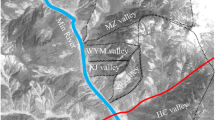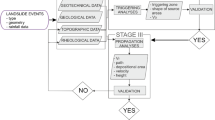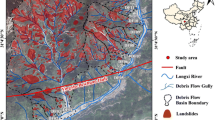Abstract
At a regional scale, the concurrent occurrence of multiple post-seismic debris flows has been commonly encountered due to abundant source materials, of which spatial distribution is crucial for the debris flow hazard assessment. So far, quantitative assessments of post-seismic debris flows at a regional scale are still limited, especially with the consideration of the spatial distribution of source materials. In the present study, a framework for post-seismic debris flows hazard assessment at the regional scale is proposed, considering topography, source materials and rainfall, based on the depth-integrated particle method coupled with a soil–water mixing model. In particular, the Beichuan region, where was one of the most damaged regions during the 2008 Wenchuan earthquake, is chosen as a case study. The spatial distribution of source materials, which is identified based on the high-resolution imagery, is considered during the hazard assessment. Simulation results show that the delineated post-seismic debris flow map, based on the computed specific affected area, is in fairly good agreement with field investigations in the Beichuan region after the earthquake event. Regional hazard assessment shows that the destructive potential of post-seismic debris flows to the Beichuan city is amplified, comparing with that evaluated separately at a catchment scale. The enhanced destructive potential is mainly attributed to the coupling effects between multiple debris flows in terms of discharge and velocity. In addition, the magnitude and intensity of post-seismic debris flows considering the spatial distribution of source materials are computed more accurately than those only estimated by rainfall and topography. This study implies that the regional assessment framework considering the spatial distribution of source materials, topography and rainfall can provide reasonable and reliable physical–mechanical parameters in practical engineering, avoiding underestimation of hazard assessment or unreasonable prevention and mitigation strategies.









Similar content being viewed by others
Data availability
The datasets used and/or analysed during the current study are available from the corresponding author on reasonable request.
References
Bernard M, Gregoretti C (2021) The use of rain gauge measurements and radar data for the model-based prediction of runoff-generated debris-flow occurrence in early warning systems. Water Resour Res 57:e2020WR027893. https://doi.org/10.1029/2020WR027893
Bovis MJ, Jakob M (1999) The role of debris supply conditions in predicting debris flow activity. Earth Surf Process Landforms 24:1039–1054
Chang M, Tang C, van Asch TWJ, Cai F (2017) Hazard assessment of debris flows in the Wenchuan earthquake-stricken area, south west China. Landslides 14:1783–1792. https://doi.org/10.1007/s10346-017-0824-9
Chen HX, Zhang S, Peng M, Zhang LM (2016) A physically-based multi-hazard risk assessment platform for regional rainfall-induced slope failures and debris flows. Eng Geol 203:15–29. https://doi.org/10.1016/j.enggeo.2015.12.009
Chen NS, Yang CL, Zhou W, Hu GS, Li H, Han D (2009) The critical rainfall characteristics for torrents and debris flows in the Wenchuan earthquake stricken area. J Mt Sci 6:362–372. https://doi.org/10.1007/s11629-009-1064-9
Chigira M, Wu X, Inokuchi T, Wang G (2010) Landslides induced by the 2008 Wenchuan earthquake, Sichuan, China. Geomorphology 118(3–4):225–238. https://doi.org/10.1016/j.geomorph.2010.01.003
Croissant T, Lague D, Steer P, Davy P (2017) Rapid post-seismic landslide evacuation boosted by dynamic river width. Nat Geosci 10:680–684. https://doi.org/10.1038/ngeo3005
Dahlquist MP, West AJ (2019) Initiation and runout of post-seismic debris flows: insights from the 2015 Gorkha Earthquake. Geophys Res Lett 46:9658–9668. https://doi.org/10.1029/2019GL083548
Domènech G, Fan XM, Scaringia G, van Asch TWJ, Xu Q, Huang RQ, Hales TC (2019) Modelling the role of material depletion, grain coarsening and revegetation in debris flow occurrences after the 2008 Wenchuan earthquake. Eng Geol 250:34–44. https://doi.org/10.1016/j.enggeo.2019.01.010
Fan RL, Zhang LM, Wang HJ, Fan XM (2018) Evolution of debris flow activities in Gaojiagou Ravine during 2008–2016 after the Wenchuan earthquake. Eng Geol 235(9):1–10. https://doi.org/10.1016/j.enggeo.2018.01.017
Guo X, Cui P, Li Y, Ma L, Ge Y, Mahoney WB (2016) Intensity-duration threshold of rainfall-triggered debris flows in the Wenchuan earthquake affected area, China. Geomorphology 253:208–216. https://doi.org/10.1016/j.geomorph.2015.10.009
Hirschberg J, Fatichi S, Bennett GL, McArdell BW, Peleg N, Lane SN et al (2021) Climate change impacts on sediment yield and debris-flow activity in an Alpine catchment. J Geophys Res Earth Surf 126:2020005739. https://doi.org/10.1029/2020JF005739
Hu W, Scaringi G, Xu Q, Huang R (2018) Internal erosion controls failure and runout of loose granular deposits: evidence from flume tests and implications for postseismic slope healing. Geophys Res Lett 45:5518–5527. https://doi.org/10.1029/2018GL078030
Hu XD, Hu KH, Tang JB, You Y, Wu CH (2019) Assessment of debris-flow potential dangers in the Jiuzhaigou valley following the August 8, 2017, Jiuzhaigou earthquake, western China. Eng Geol 256:57–66. https://doi.org/10.1016/j.enggeo.2019.05.004
Huang RQ, Li WL (2009) Analysis of the geo-hazards triggered by the 12 May 2008 Wenchuan Earthquake, China. Bull Eng Geol Environ 68:363–371. https://doi.org/10.1007/s10064-009-0207-0
Hungr O (2015) Analysis of debris flow surges using the theory of uniformly progressive flow. Earth Surf Process Landforms 25:483–495
Kean JW, McCoy SW, Tucker GE, Staley DM, Coe JA (2013) Runoff-generated debris flows: observations and modeling of surge initiation, magnitude, and frequency. J Geophys Res Earth Surf 118:2190–2207. https://doi.org/10.1002/jgrf.20148
Koi T, Hotta N, Ishigaki I, Matuzaki N, Uchiyama Y, Suzuki M (2008) Prolonged impact of earthquake-induced landslides on sediment yield in a mountain watershed: The Tanzawa region, Japan. Geomorphology 101(4):692–702. https://doi.org/10.1016/j.geomorph.2008.03.007
Konagai K, Ishikawa Y, Tsuchiya S, Wang FW (2009) Geotechnical issues caused by the May 12th 2008, Wenchuan earthquake, China. Bull ERS 42:33–42
Li G, West AJ, Densmore AL, Hammond DE, Jin Z, Zhang F, Wang J, Hilton RG (2016) Connectivity of earthquake-triggered landslides with the fluvial network: Implications for landslide sediment transport after the 2008 Wenchuan earthquake. J Geophys Res Earth Surf. https://doi.org/10.1002/2015JF003718
Lin CW, Shieh CL, Yuan BD, Shieh YC, Liu SH, Lee SY (2003) Impact of Chi-Chi earthquake on the occurrence of landslides and debris flows: example from the Chenyuan River watershed, Nantou, Taiwan. Eng Geol 71:49–61. https://doi.org/10.1016/S0013-7952(03)00125-X
Liu FZ, Xu Q, Dong XJ, Yu B, Frost JD, Li HJ (2017) Design and performance of a novel multi-function debris flow mitigation system in Wenjia Gully, Sichuan. Landslides 14(6):2089–2104. https://doi.org/10.1007/s10346-017-0849-0
Liu JF, You Y, Chen XC, Fan JR (2010) Identification of potential sites of debris flows in the upper min river drainage, following environmental changes caused by the Wenchuan earthquake. J Mt Sci 7:255–263
Ma C, Wang YJ, Hu KH, Du C, Yang WT (2017) Rainfall intensity–duration threshold and erosion competence of debris flows in four areas affected by the 2008 Wenchuan earthquake. Geomorphology 282:85–95. https://doi.org/10.1016/j.geomorph.2017.01.012
Mu QY, Zhou C, Ng Charles WW (2020) Compression and wetting induced volumetric behavior of loess: micro- and macro-investigations. Trans Geotech 23:100345. https://doi.org/10.1016/j.trgeo.2020.100345
Ouyang CJ, He S, Tang C (2015) Numerical analysis of dynamics of debris flow over erodible beds in Wenchuan earthquake-induced area. Eng Geol 194:62–72. https://doi.org/10.1016/j.enggeo.2014.07.012
Parker NP, Densmore AL, Rosser NJ, Michele MD, Li Y, Huang RQ, Whadcoat S, Petley DN (2011) Mass wasting triggered by the 2008Wenchuan earthquake greater than orogenic growth. Nat Geosci 4:449–452
Rickenmann D (1999) Empirical relationships for debris flows. Nat Hazards 19:47–77. https://doi.org/10.1023/A:1008064220727
Shafique M (2020) Spatial and temporal evolution of co-seismic landslides after the 2005 Kashmir earthquake. Geomorphology 362:107228. https://doi.org/10.1016/j.geomorph.2020.107228
Shi ZM, Guan SG, Peng M, Zhang LM, Zhu Y, Cai QP (2015) Cascading breaching of the Tangjiashan landslide dam and two smaller downstream landslide dams. Eng Geol 193(2):445–458. https://doi.org/10.1016/j.enggeo.2015.05.021
Shieh CL, Chen YS, Tsai YJ, Wu JH (2009) Variability in rainfall threshold for debris flow after the Chi-Chi earthquake in central Taiwan, China. Int J Sediment Res 24:177–188
Tang C, Zhu J, Li WL (2009) Rainfall triggered debris flows after Wenchuan Earthquake. Bull Eng Geol Environ 68:187–194. https://doi.org/10.1007/s10064-009-0201-6
Tang C, Zhu J, Qi X, Ding J (2011) Landslides induced by the Wenchuan earthquake and the subsequent strong rainfall event: a case study in the Beichuan area of China. Eng Geol 122:22–33. https://doi.org/10.1016/j.enggeo.2011.03.013
Tang C, Zhu J, Chang M, Ding J, Qi X (2012) An empirical statistical model for predicting debris-flow runout zones in the Wenchuan earthquake. Quatern Int 250:63–73. https://doi.org/10.1016/j.quaint.2010.11.020
Wu S, Chen J, Xu C, Zhou W, Yao LH, Yue W, Cui ZJ (2020) Susceptibility assessments and validations of debris-flow events in meizoseismal areas: case study in China’s Longxi river watershed. Nat Hazards Rev 21(1):05019005113
Xiong J, Tang C, Chen M, Zhang XZ, Shi QY, Gong LF (2020) Activity characteristics and enlightenment of the debris flow triggered by the rainstorm on 20 August 2019 in Wenchuan County, China. Bull Eng Geol Environ. https://doi.org/10.1007/s10064-020-01981-x
Xu Q, Zhang S, Li WL (2012) van Asch TWJ (2012) The 13 august 2010 catastrophic debris flows after the 2008 Wenchuan earthquake, China. Hazards Earth Syst Sci 12:201–216. https://doi.org/10.5194/nhess-12-201-2012
Yin YP, Wang FW, Sun P (2008) Landslide hazards triggered by the 12 May 2008Wenchuan Earthquake, Sichuan, China. Proc. 1st World Landslide Forum, Parallel Session Volume, pp 1–17
Yin YP, Wang FW, Sun P (2009) Landslide hazards triggered by the 2008 Wenchuan earthquake, Sichuan, China. Landslides 6:139–151. https://doi.org/10.1007/s10346-009-0148-5
You Y, Liu JF, Chen XZ (2011) Disaster characteristics and optimal design of drainage canal of debris flow following Wenchuan earthquake in Weigou gully in Beichuan county, Sichuan province, China. Italian J Eng Geol Environ 805–811. http://192.168.143.20:8080/handle/131551/4758
Yu B, Wu Y, Chu S (2014) Preliminary study of the effect of earthquakes on the rainfall threshold of debris flows. Eng Geol 182:130–135. https://doi.org/10.1016/j.enggeo.2014.04.007
Zhang N, Matsushima T (2016) Simulation of rainfall-induced debris flow considering material entrainment. Eng Geol 214:107–115. https://doi.org/10.1016/j.enggeo.2016.10.005
Zhang N, Matsushima T (2018) Numerical investigation of debris materials prior to debris flow hazards using satellite images. Geomorphology 308:54–63. https://doi.org/10.1016/j.geomorph.2018.02.008
Zhang N, Sun Q (2021) Quantitative investigation of the spatiotemporal evolution of coseismic deposits and its influence on the magnitude of postseismic debris flows in the Hongchun valley, Wenchuan County, China. Landslide. https://doi.org/10.1007/s10346-021-01754-x
Zhang S, Zhang LM (2017) Impact of the 2008 Wenchuan earthquake in China on subsequent long-term debris flow activities in the epicentral area. Geomorphology 276:86–103. https://doi.org/10.1016/j.geomorph.2016.10.009
Zhang N, Matsushima T, Peng NB (2019) Numerical investigation of post-seismic debris flows in the epicentral area of the Wenchuan earthquake. Bull Eng Geol Environ 78(5):3253–3268. https://doi.org/10.1007/s10064-018-1359-6
Zhou W, Tang C (2014) Rainfall thresholds for debris flow initiation in the Wenchuan earthquake-stricken area, South-western China. Landslides 11:877–887. https://doi.org/10.1007/s10346-013-0421-5
Zhu J, Ding J, Liang JT (2011) Influences of the Wenchuan earthquake on sediment supply of debris flows. J Mt Sci 8:270–277. https://doi.org/10.1007/s11629-011-2114-7
Zhuang JQ, Cui P, Hu KH, Chen XQ, Ge YG (2010) Characteristics of earthquake-triggered landslides and post-earthquake debris flows in Beichuan County. J Mt Sci 7:246–254. https://doi.org/10.1007/s11629-010-2016-0
Acknowledgements
The authors wish to express their gratitude for the financial support from the National Natural Science Foundation of China (No. 41807257 and 51909205).
Funding
The work was funded by the National Natural Science Foundation of China (No. 41807257 and 51909205).
Author information
Authors and Affiliations
Corresponding author
Ethics declarations
Conflict of interest
The authors declare that they have no competing interests.
Ethical approval
This is non-human subject research, and waived the need for informed consent.
Informed consent
All authors contributed to the study conception and design. All authors read and approved the final manuscript.
Additional information
Publisher's Note
Springer Nature remains neutral with regard to jurisdictional claims in published maps and institutional affiliations.
Rights and permissions
About this article
Cite this article
Zhang, N., Mu, Q. Quantitative investigation of post-seismic debris flows considering the spatial distribution of source materials. Environ Earth Sci 80, 713 (2021). https://doi.org/10.1007/s12665-021-10048-3
Received:
Accepted:
Published:
DOI: https://doi.org/10.1007/s12665-021-10048-3




